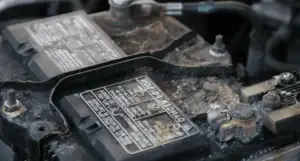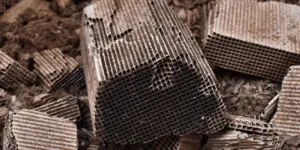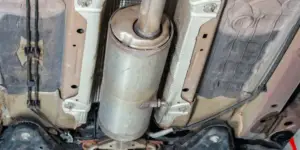Sometimes after having their catalytic converter replaced, drivers complain about a smell. It’s often compared to sulfur, rotten egg, or a burning plastic smell.
This smell can be normal for a while, but if it continues, it could be a sign there is still an issue.
Before we cover whether it is dangerous or a sign of a faulty replacement, we’ll briefly – very briefly – explain how a catalytic converter works.
How Converters Work And When They Need To Be Replaced
Catalytic converters are a filter for your exhaust. The materials converters are made of create a chemical reaction with the exhaust gasses, breaking them down so that what’s coming out of the tailpipe is less harmful to us and the environment.
Just like your car’s air or oil filter that needs to be replaced periodically. Converters can wear out over time and need to be replaced too.
Did your car have a mechanical fault such as a misfire, was it running too rich, or had a faulty bad oxygen sensor? These faults will always wear and clog the catalytic converter sooner. Sometimes, – as you have probably attempted- cleaning or regeneration is less likely to work if these faults are present.
Your old faulty converter would have produced exhaust gasses that would be more harmful, your car’s fuel mileage would be reduced, and it can cause the car to have less power and run rough. As the converter worsens, your car may go into limp mode, and the engine warning light might have come on too.
Under normal conditions, a converter should last well over 100,000 miles.
If there is a mechanical fault with your car’s engine, the converter can be damaged within a few thousand miles. Depending on your climate, your converter may also need to be replaced because of rust.
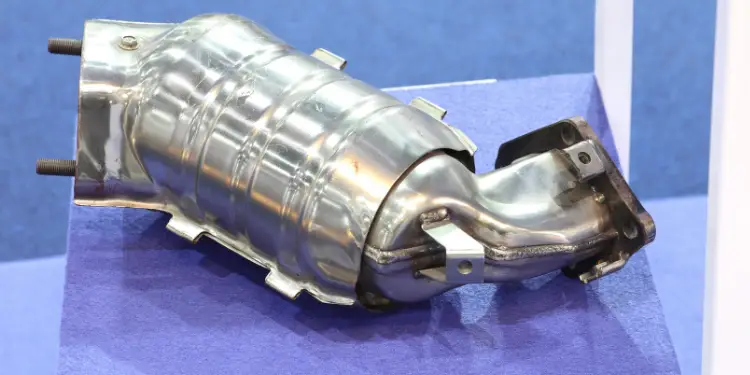
What Causes The Smell
When a converter is new, it’s normal to smell for a little while. Manufacturers will usually lightly coat them with oil to prevent rust from starting while sitting on the shelf at the auto parts store. There are also usually labels attached to them that contain the part number or barcode. As this oil and adhesive residue is burning off, you will likely be able to smell it. They can also smell for a little while as they are breaking in.
Because converters are designed to cause a chemical reaction in the exhaust, if the engine isn’t running efficiently, the chemical reaction will not be working properly, and you will probably be able to smell it.
If a smell continues for more than a few hundred miles after the converter was replaced, that could be a sign there is a problem.
When a car has a mechanical issue, it can cause damage to the converter. For example, the converter can prematurely fail if a car has a misfire, is burning oil, has a bad head gasket, clogged air or fuel filter, or has bad oxygen sensors. The check engine light will usually come on for many of these issues. These mechanical issues can cause the converter to become clogged.
Motor oil getting into the exhaust or the engine running rich can cause the converter to overheat.
This is important:
If a shop replaced the converter on your car, you should ask them if it went bad because of normal wear and age or if it failed because of another mechanical issue.
If there is another mechanical issue, that should be fixed as soon as possible to prevent damage to the new converter.
Furthermore, some cars have more than one converter on them. Some have up to four. It depends on how many individual exhaust pipes your car has. Each tailpipe has a separate cat fitted to it.
If you recently had a shop replace the converter on your car, find out how many your car has and how many the shop replaced.
If they didn’t replace them all, there could still be an issue with the one or the ones they didn’t replace. This should have been discussed before any work on your car was started.
Is A New Catalytic Converter Smell Dangerous?
The exhaust that comes out of our cars isn’t good for us. It contains carbon monoxide and other harmful chemicals.
Since the converter’s job is to “filter” that exhaust, the exhaust will be more harmful than normal if the converter isn’t working as designed.
However, in the first hundred miles or so, the smell is likely to be oil the cat was covered in or the adhesive the labels were stuck on with burning off.
How To Break In A New Catalytic Converter
There is a break-in procedure for new converters. The shop that replaced it may have done it.
To break in a new converter, start the car and let it idle until it reaches normal operating temperature. Then step on the gas pedal, rev the car up to 2500 RPM and hold it there for 2 minutes.
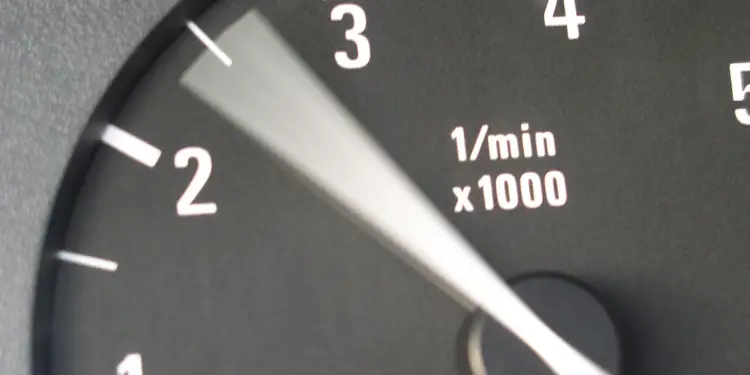
Then shut the car off and let it cool down completely. The converter will then be broken in and ready for normal driving. Doing this break-in procedure allows the converter to slowly heat up the first time.
Can A New Catalytic Converter Be Bad Out Of The Box?
If you recently had your converter replaced and it still smells after a few hundred miles, you may want to take it back to the shop and have it checked. You’ve paid a lot of money for it, after all.
With a professional scan tool, a mechanic can look at live vehicle data to see how the converter works. This data will tell them if the converter is functioning properly or not.
With the OBD scan tool, they can make sure the oxygen sensors are working, see if the car is running too rich, and see if it’s misfiring.

They can also scan the systems to see if there are any other issues with the car that could harm the new converter or be causing it to smell.
They can also check exhaust temperature before and after the converter. On a properly functioning converter, the exhaust temperature will be higher as it enters the converter than when it leaves.
It’s rare, but a new converter can be defective, especially if it is an aftermarket economy part. OEM parts are better but more expensive.
A mechanic can determine if this is the case by the tests listed above. If that shop dismisses your concerns or you don’t trust the answer they give you, you may want a second opinion from a reputable shop.
Replacing a catalytic converter is expensive. The last thing you want to do is have it prematurely fail because some other issue was ignored.
Will A New Catalytic Converter Smoke?
It’s normal to pay more attention to the performance of a new part, especially one as expensive as a catalytic converter.
A new catalytic converter can smoke because of the oil being burned off the exterior that was coated onto it to prevent rust before it left the factory or, more briefly, as the adhesive used to stick on a label is burned off.
No smoke should come from where the converter has been fitted onto the tailpipe. This signifies that it is fitted badly or hasn’t been welded in place well enough.

If you mean will it cause smoke from the exhaust pipe, then yes, it will.
How much will depend on other factors that we’ve discussed, such as whether the car is running rich or whether there are other faulty parts, such as a bad oxygen sensor?
Most reputable car shops would have checked these parts already as. If they aren’t fixed, then your new catalytic converter may also fail.
A catalytic converter going through a regen cycle will cause more smoke to be emitted. However, a brand-new one will not have to complete a regen for many miles if all other car parts are working correctly.
Many visitors also read this article: Why Does My Car Smoke At High RPMs? Blue, Black or White [GUIDE]
So, if your car is creating excess smoke out of the tailpipe, it is unlikely to be the cat at fault, but a different part is likely failing. It may be a pure coincidence.
In conclusion
Manufacturers often thinly coat them with oil to stop rust from developing while they are on the shelf at the auto parts store. Also, they often apply labels with the part number or barcode. You’ll probably be able to smell it burning off as the oil and adhesive residue. As they break in, they may also smell for a short while.


